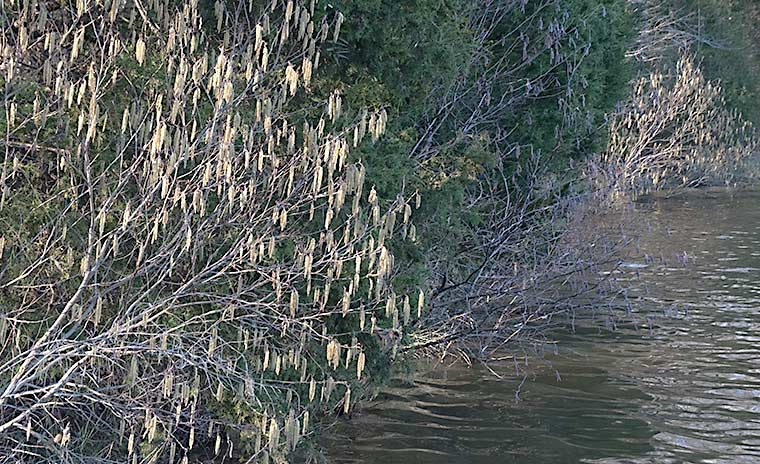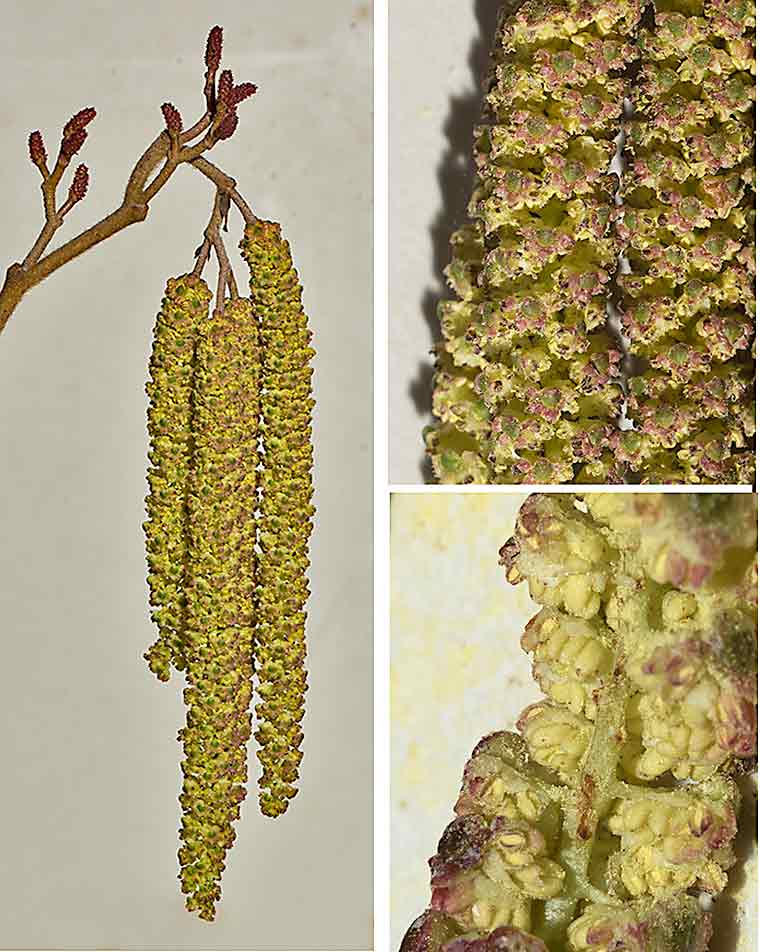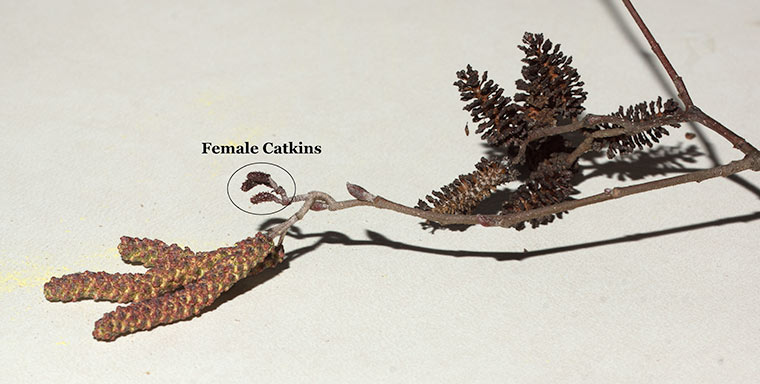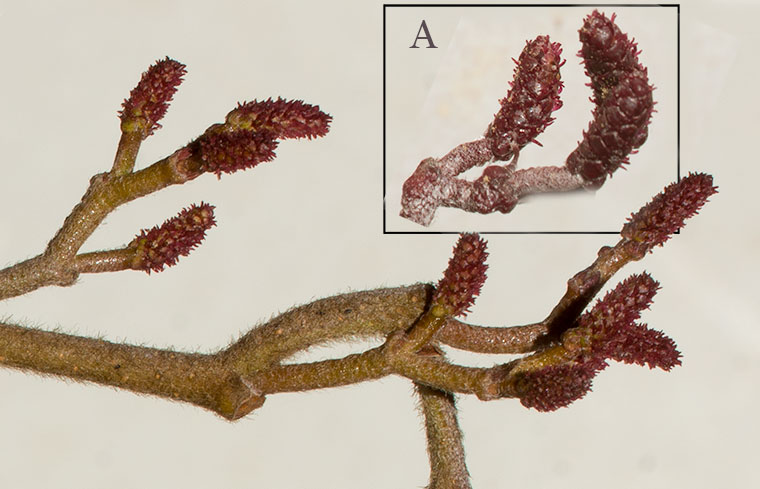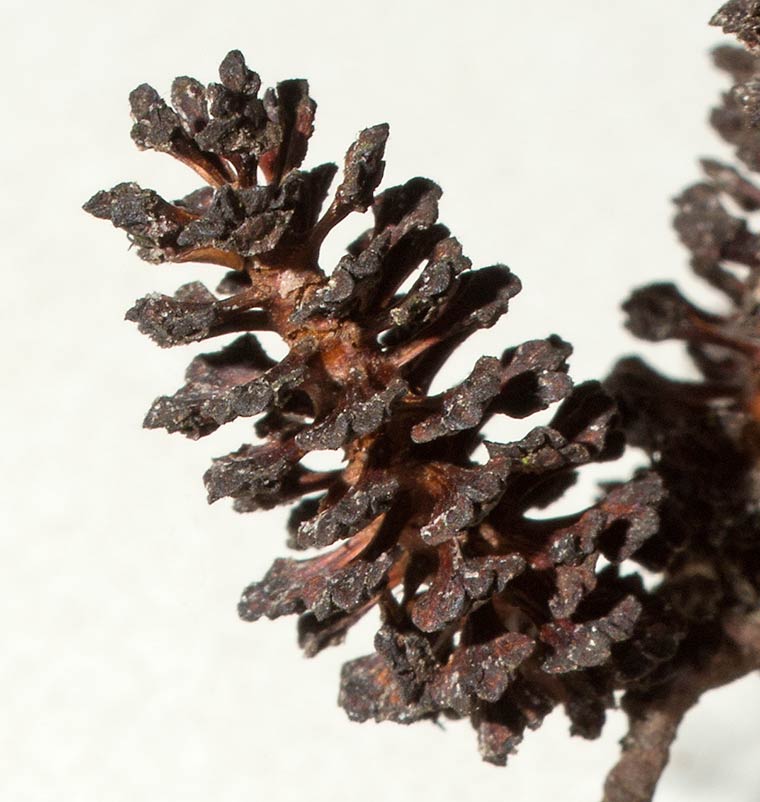A couple of days ago, it seemed as if Spring had arrived. The birds were singing mightily, and the daffodils were beginning to bloom. Yesterday we had a dust of snow on the ground, with night temperatures forecasted to be below 20 F.
During the warm period, these shrubs just next to our boat dock were in bloom even before their leaves emerged. This plant is Hazel Alder (Alnus serrulata), also called Smooth Alder or Brookside Alder. It only reaches shrub or small tree status in our area. We find it along streams and ponds; it likes a lot of moisture. This is the only species of alder found in the southeastern U.S., but 5 or 6 other species are found in northern or western parts of the U.S.
Hazel Alder is in the Birch family (Betulaceae). With the aid of some bacteria symbiotic on its roots, it is able to “fix” atmospheric nitrogen into a chemical form that is usable by plants. Thus Hazel Alder makes the soil where it grows more fertile by adding usable nitrogen.
Hazel Alder has male and female flowers on each plant, but they are separated into different structures. The male flowers (i.e. the ones that produce pollen) are the conspicuous yellow or reddish pendulous structures seen hanging from the branches. Plant sexual organs with a central column and many small, usually unisexual flowers attached are termed “catkins”, and they are produced in several species of wind-pollinated trees, such as hickories and oaks. Doubtless you have seen them littering your driveway or deck from time to time. Incidentally, The word catkin is derived from Dutch katteken, which means “kitten”. The drooping male catkins do look a bit like a kitten’s tail.
Three male catkins dangle from the twig shown in the left half of the figure above. Their sole job is to produce masses of pollen and to cast it to the wind; Hazel Alder is wind-pollinated. Closer looks at the male catkin (top right side of the figure) shows many small flowers arranged in a spiral fashion down the length of the catkin. By slicing away the surface of the catkin (right below) the central stalk with attached flowers can be seen. Each flower is on a short stalk. The many oval, yellow structures are anthers filled with pollen.
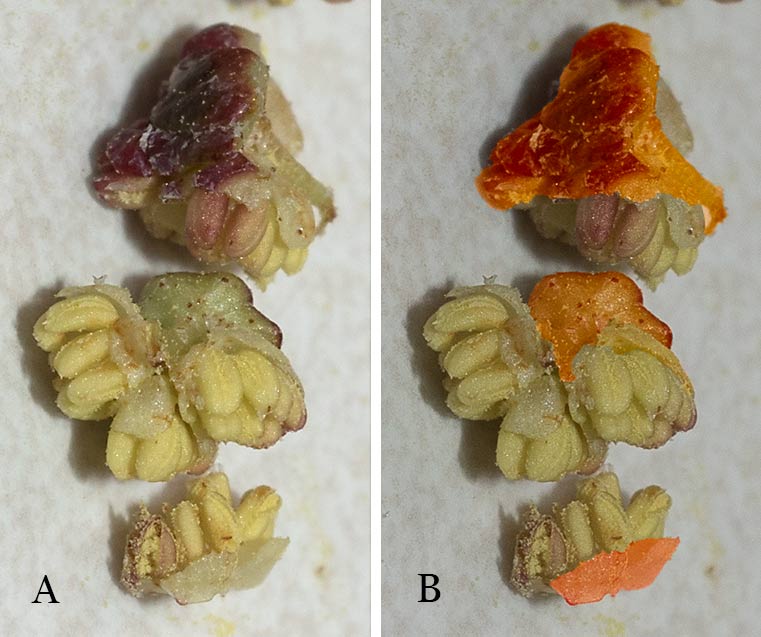
Two male flowers of Hazel Alder. A. Natural color. B. The stalk and the scale on top of the flowers is artificially colored orange.
For this figure I removed two flowers from a male catkin to show their simple structure. Each flower has a flat lobed scale on top of it. Four groups of anthers filled with pollen are attached to the underside of this scale. Each group has 6 or 8 anthers, so up to 32 anthers are present in each flower. There are no petals or other conspicuous structures. On one side of the scale the stalk that attaches the flower to the central stalk of the catkin runs down the side of the flower. On the B side of the figure, I colored the scale and stalk a sort of orange to make it stand out. The flower structure can be visualized if you bend your arm at the elbow and hold your forearm vertically; then bend your wrist to a horizontal position. Imagine a lot of anthers filled with pollen attached to the palm of your hand. Your elbow forms the attachment point to the central stalk of the “catkin”. Clear, huh?
Male catkins transform from a reddish color to a bright yellow as newly released pollen coats their surfaces.
In the photograph above the male catkins are the three structures attached to the left end of the twig. Two stages of development of female catkins are also shown in the photograph. To the right, the large structures that look like pine cones are last year’s female catkins. In between them and the male organs at the twig tip are this year’s female catkins; small, dark reddish structures that I have circled. They are more clearly visible in the photographs which follow.
A more detailed view of the young female catkins shows scales on the surface of each. The stigmas of each of the many flowers can be seen protruding from the surface, particularly in inset A. If pollen that is blowing around in the air comes in contact with one of these stigmas it will stick, fertilization will occur, and seeds will be formed.
Hazel Alder female catkins develop over the course of the summer into what look for all the world like miniature pine cones. Each of the scales seen on the surface of young female catkins has developed into a full-fledged scale that protrudes from the central axis. If pollination was successfully obtained, a single small seed will be produced under each scale. After the seeds are released, the now seedless catkins are retained on the plant for a year or more and enable easy identification of Hazel Alder in the field.
Alders grow in wet, boggy areas that may be thickly vegetated. Such places may be somewhat frightening to enter, especially at night. Thus various legends have arisen about what sort of nasty creatures might lurk in alder bogs. One of these concerns an “Erlköenig”, literally “Alder King”, with his beautiful daughters. Goethe wrote a famous poem about a father carrying his son on horseback through an alder swamp and their encounter with the Erlköenig. You can read the poem and learn much more about it if you click here.

